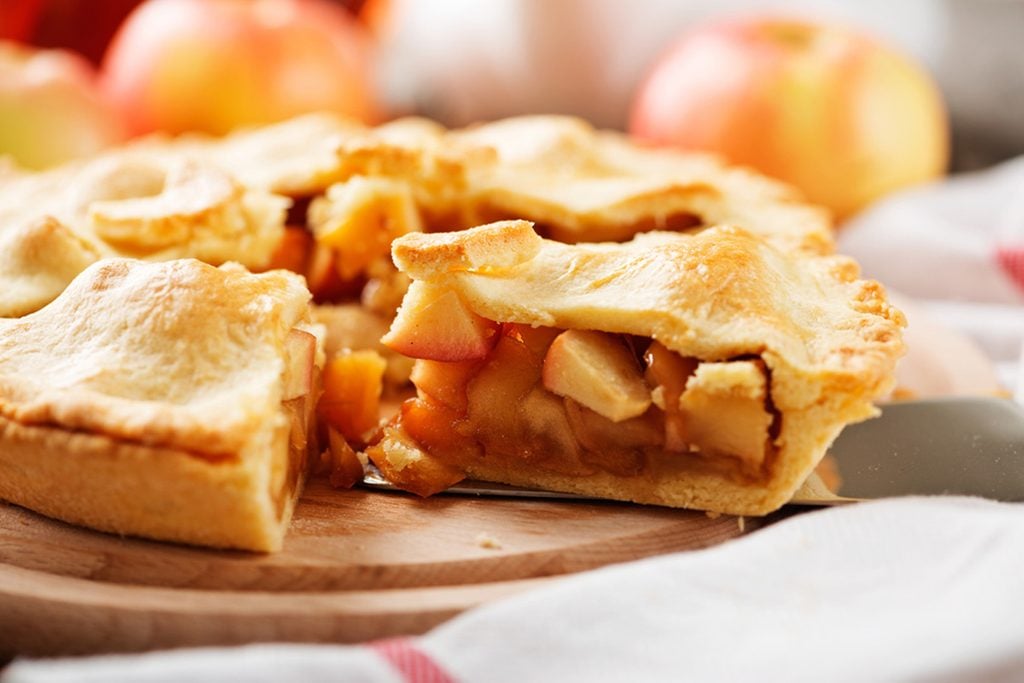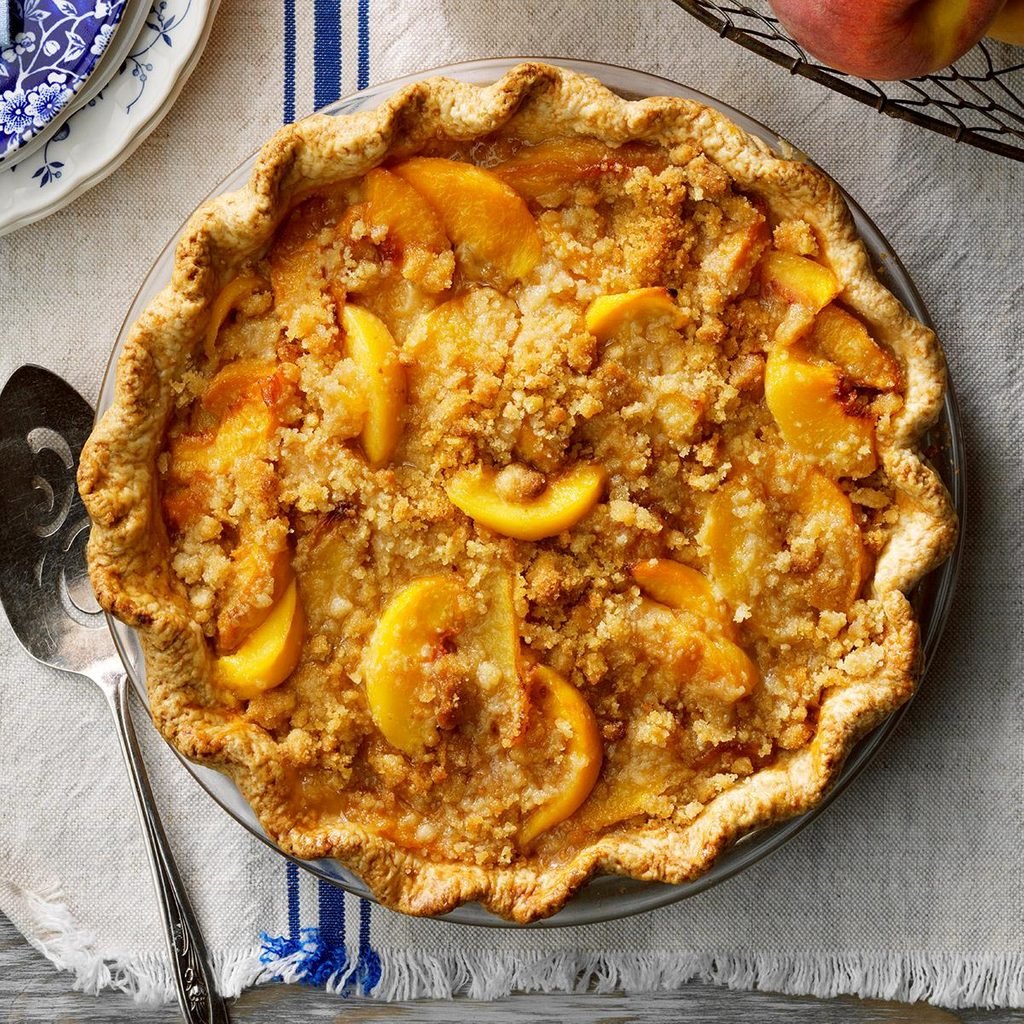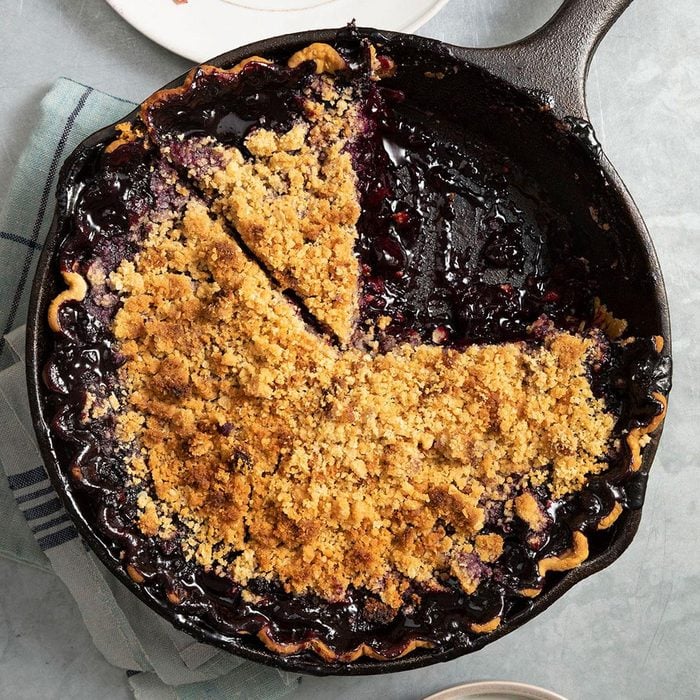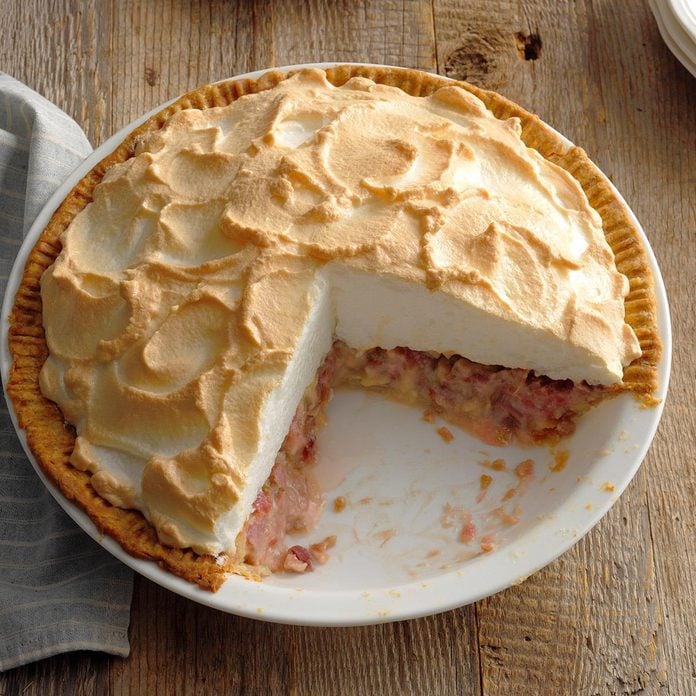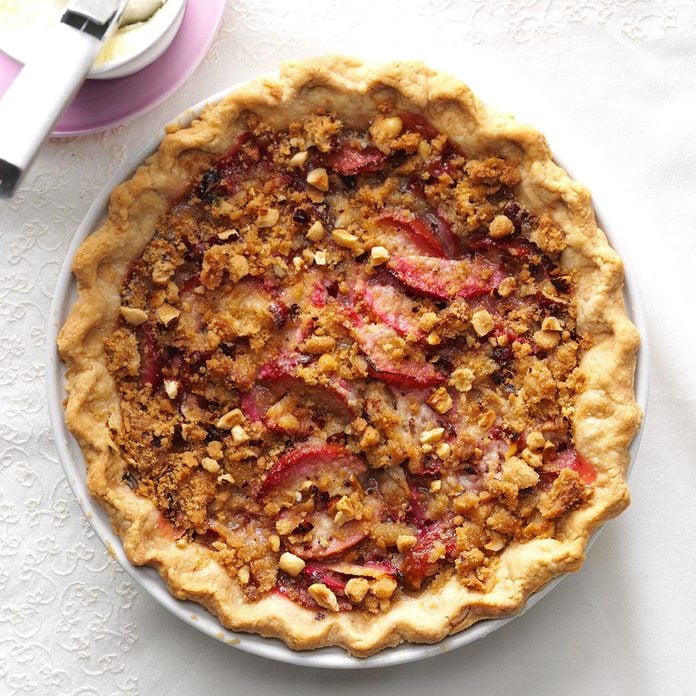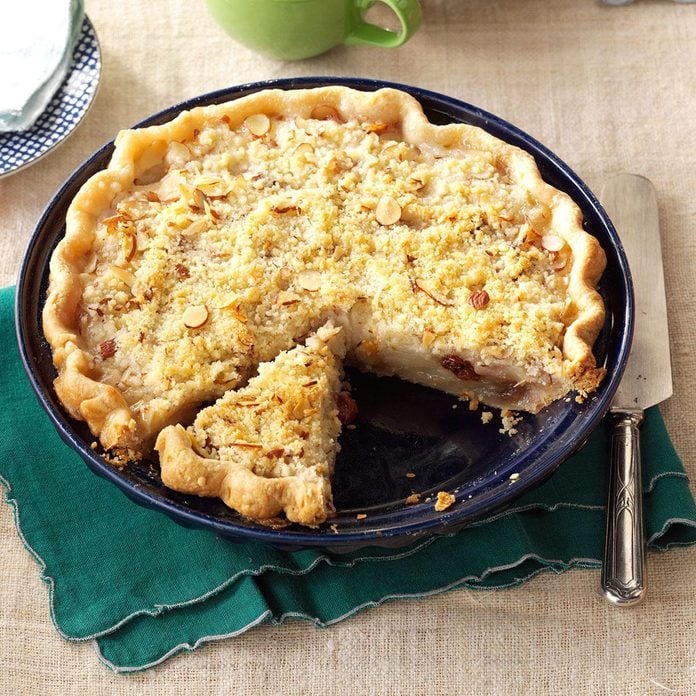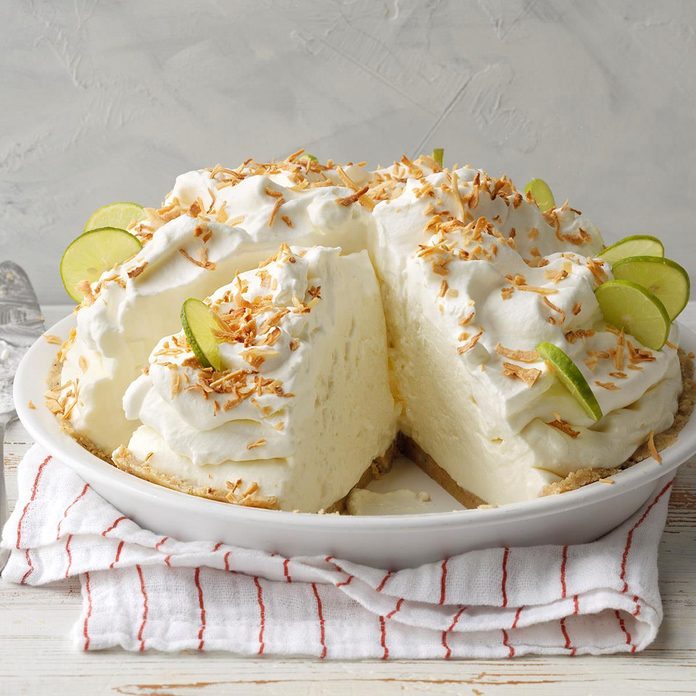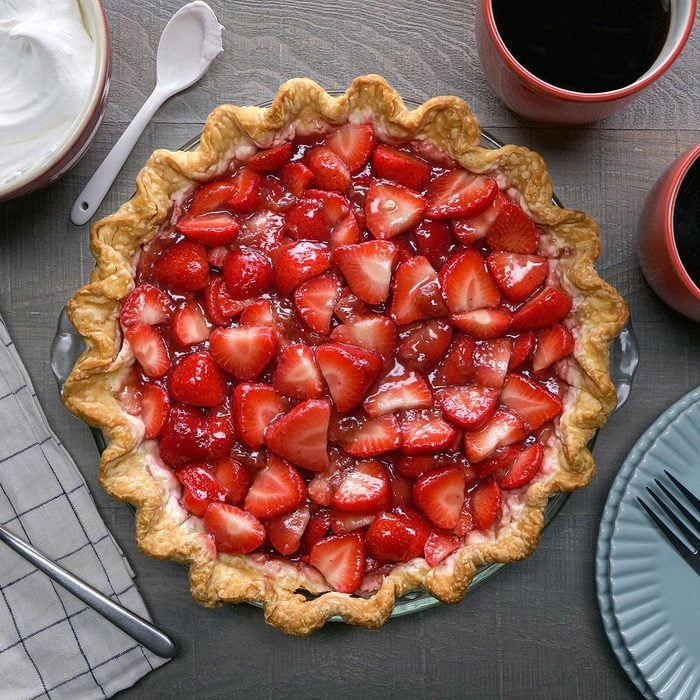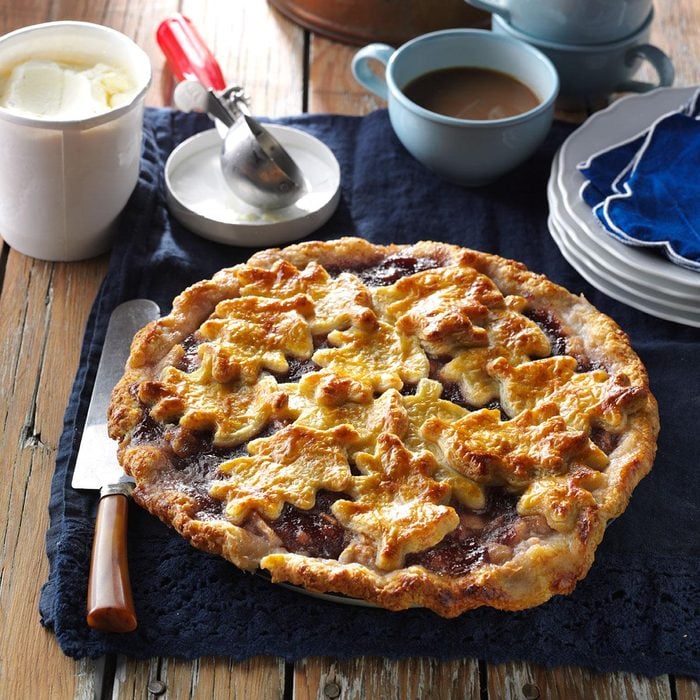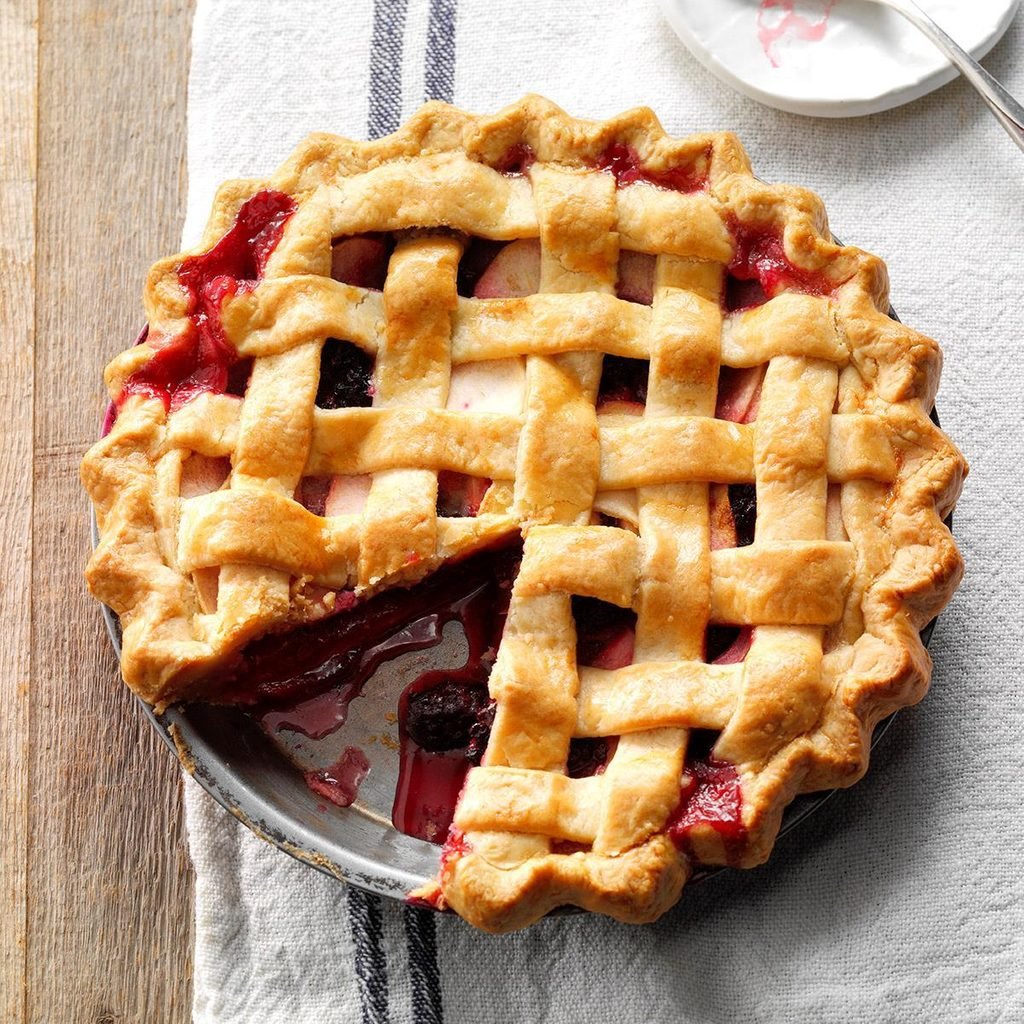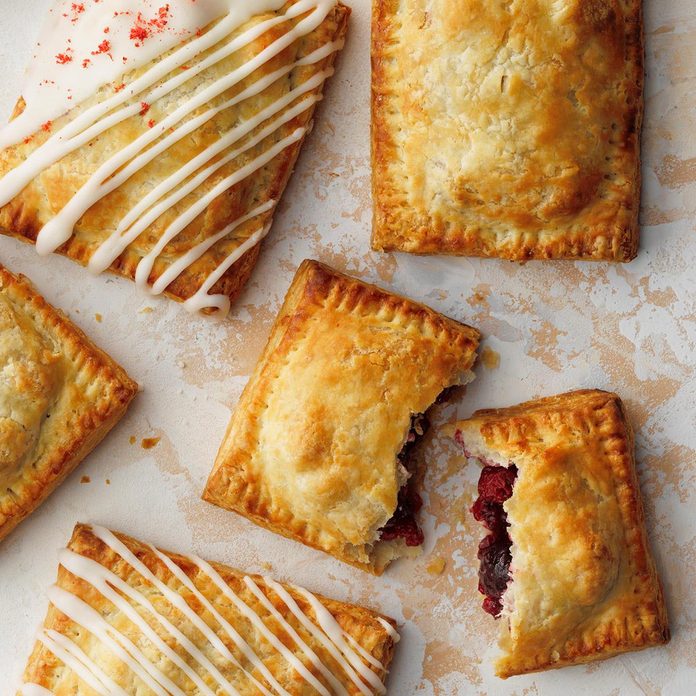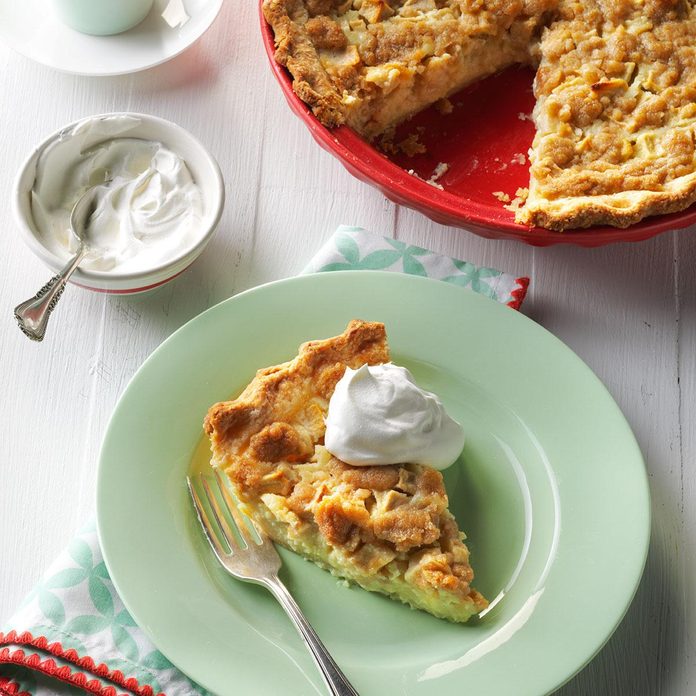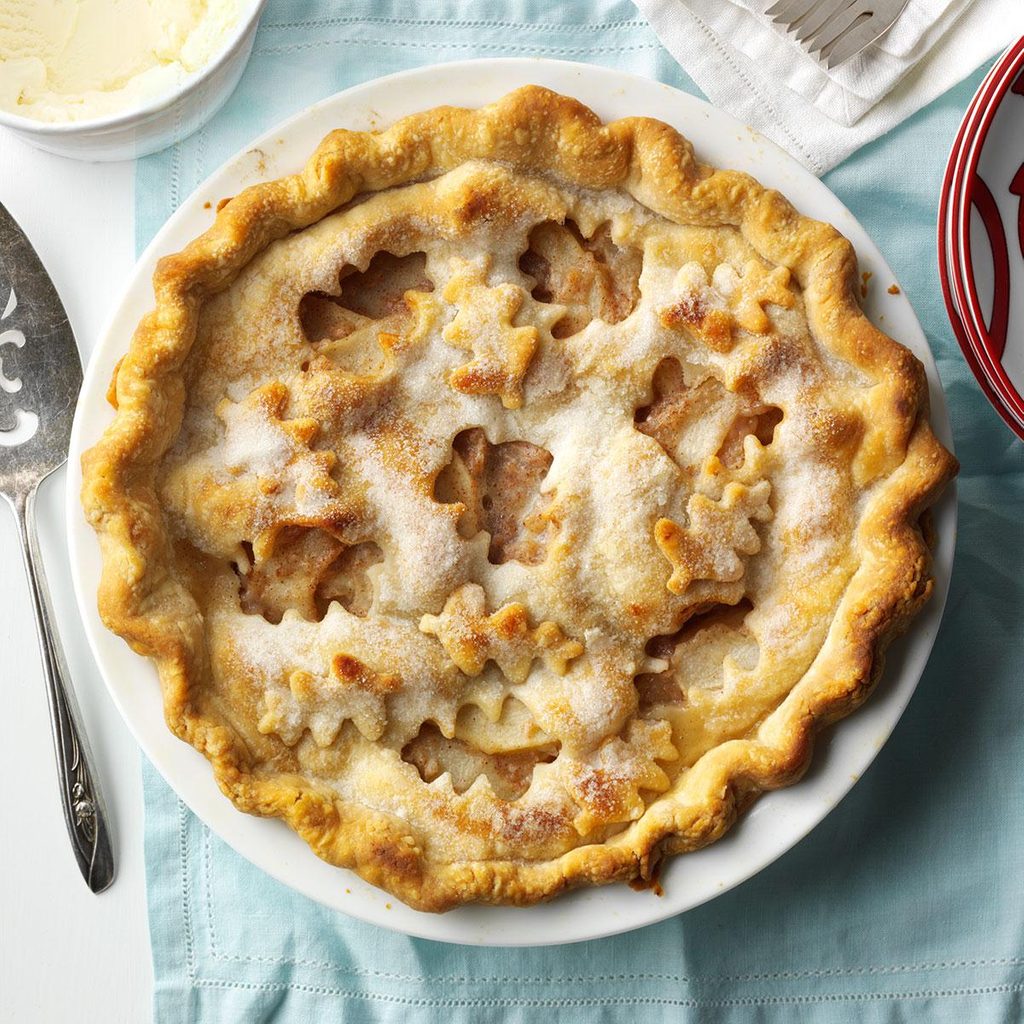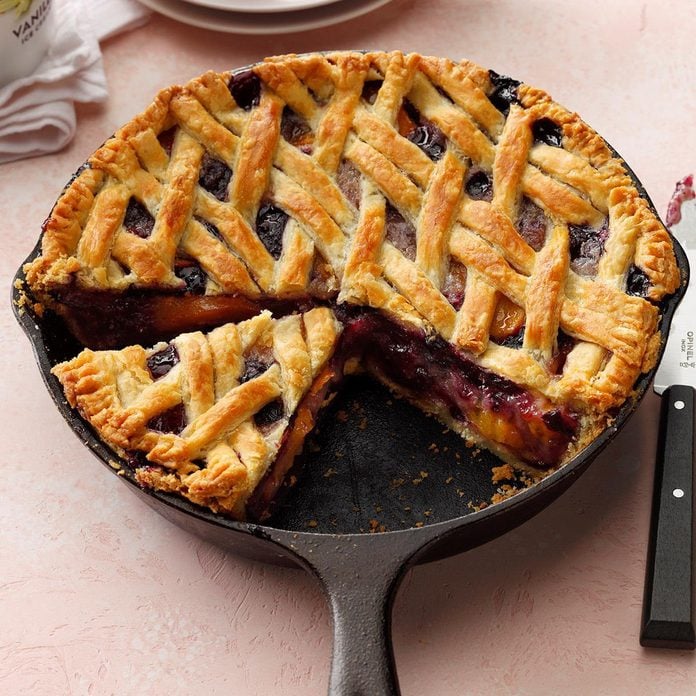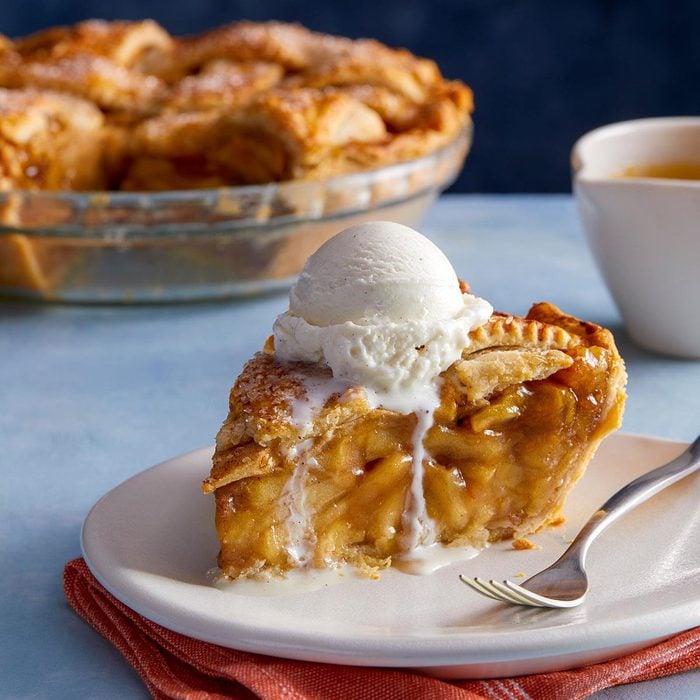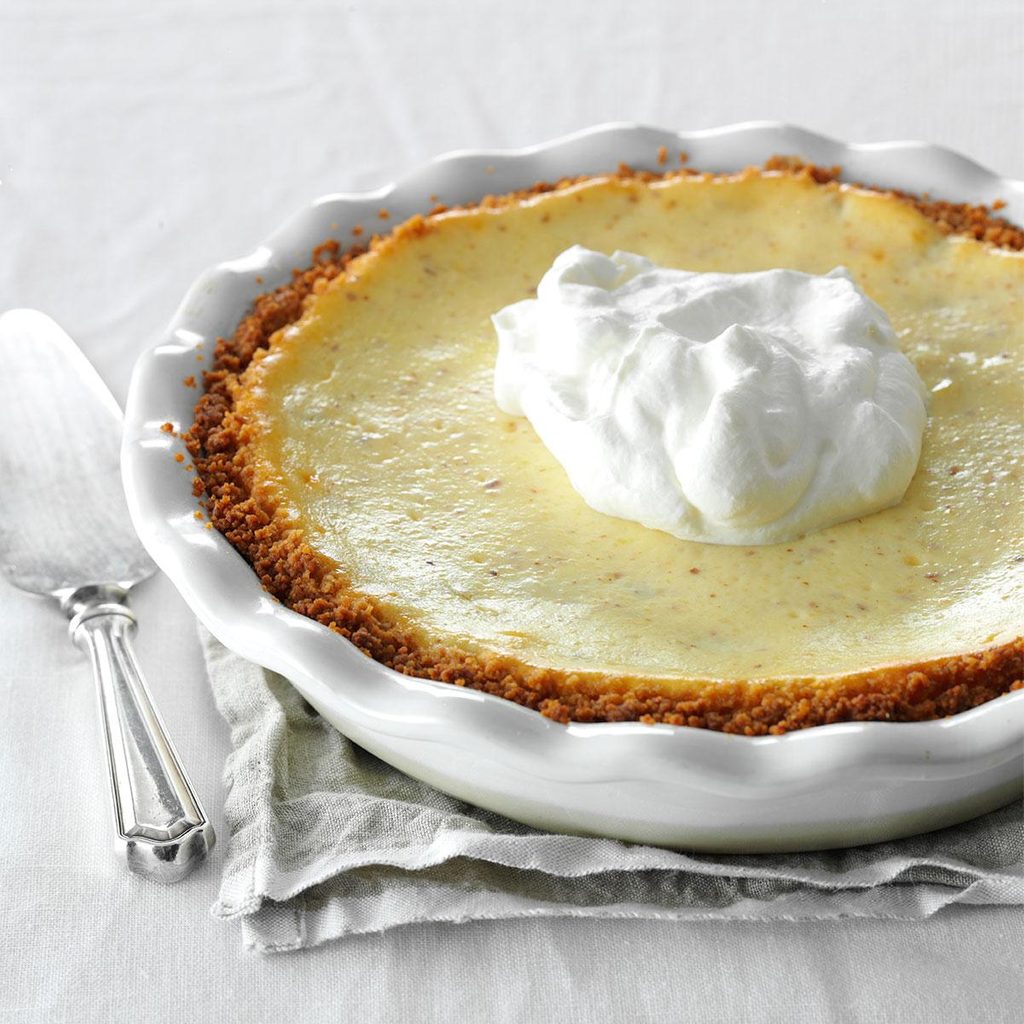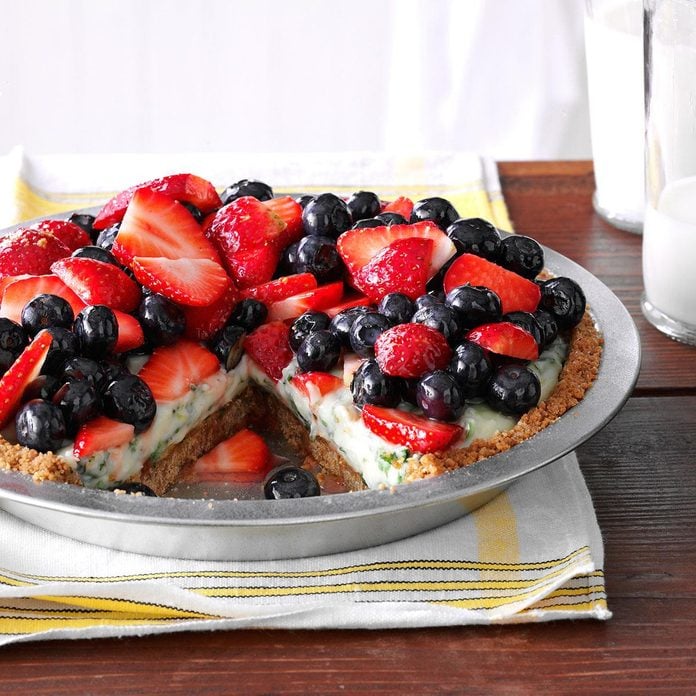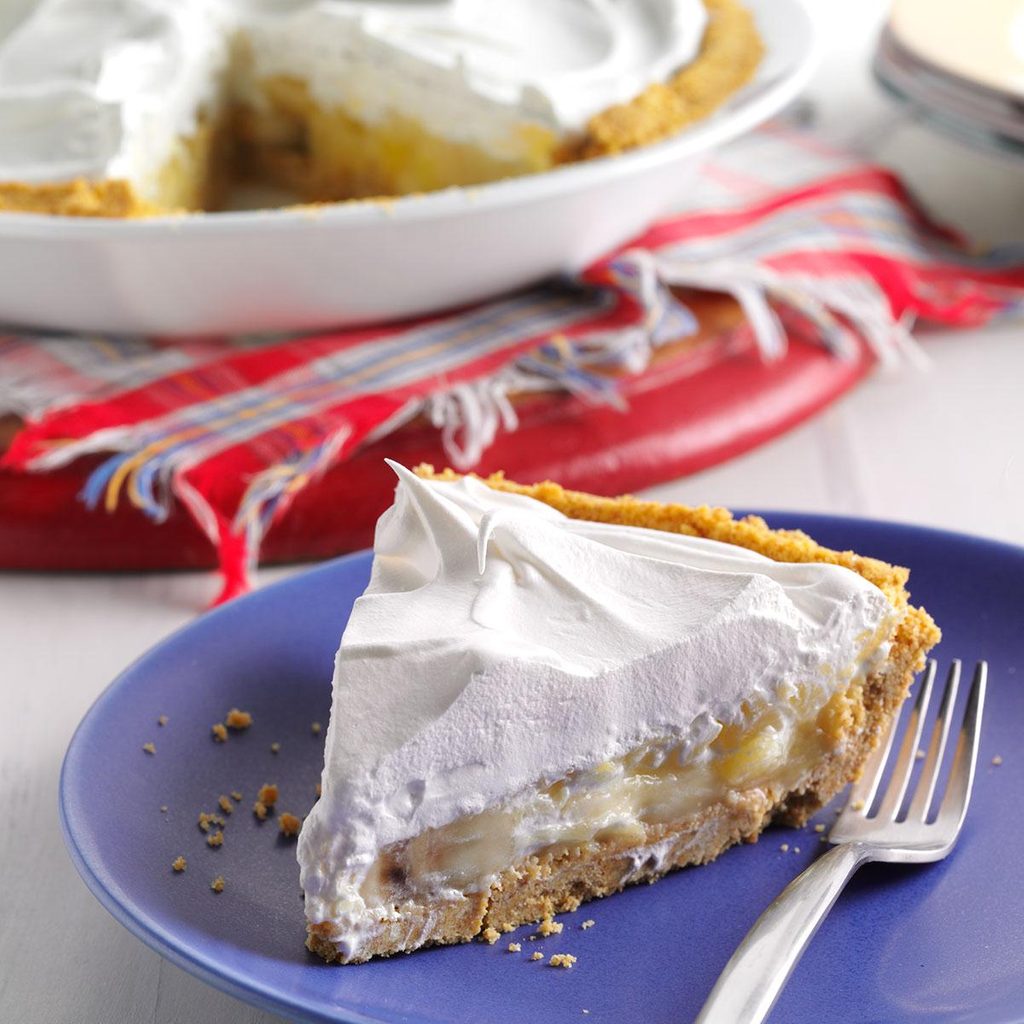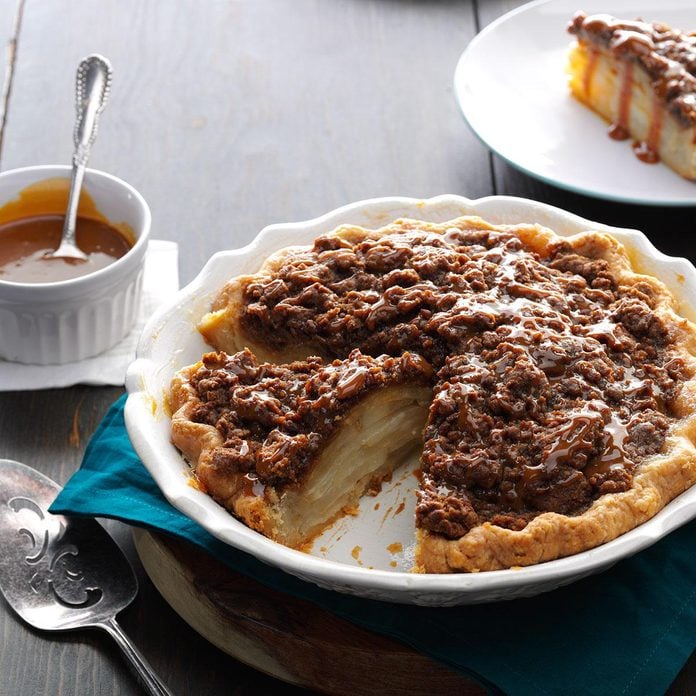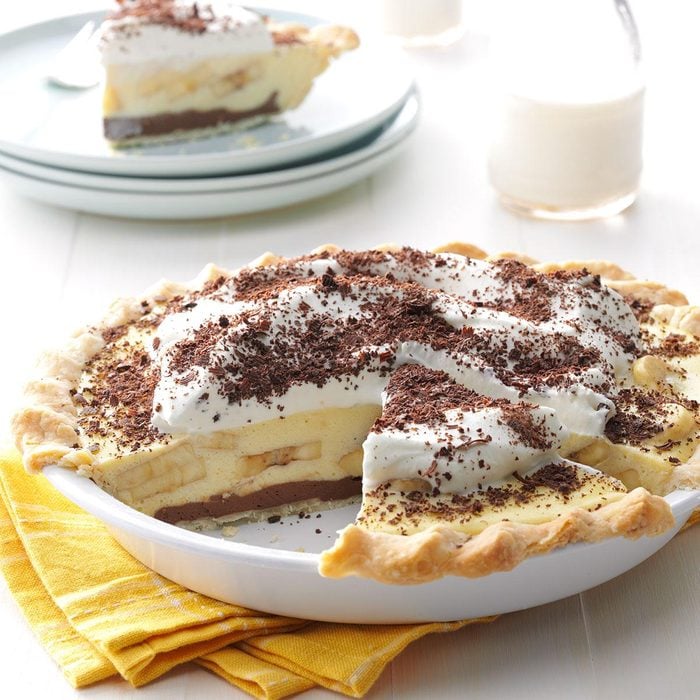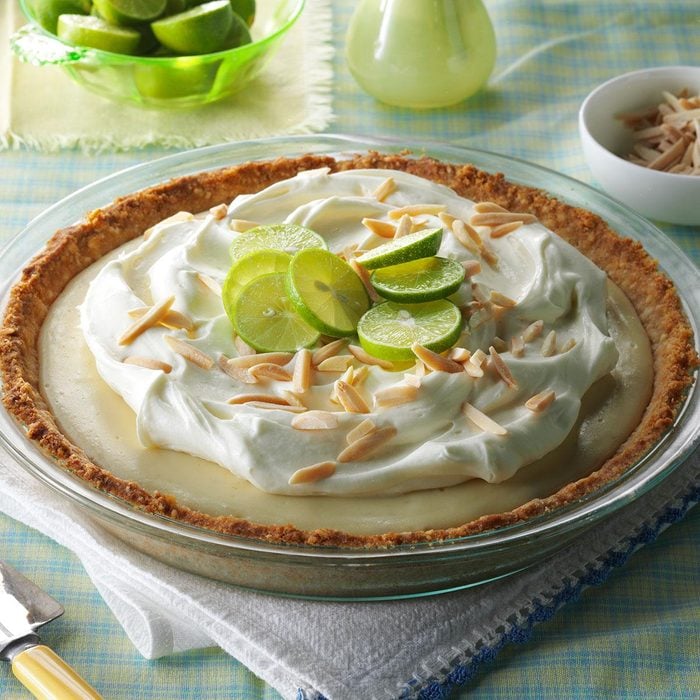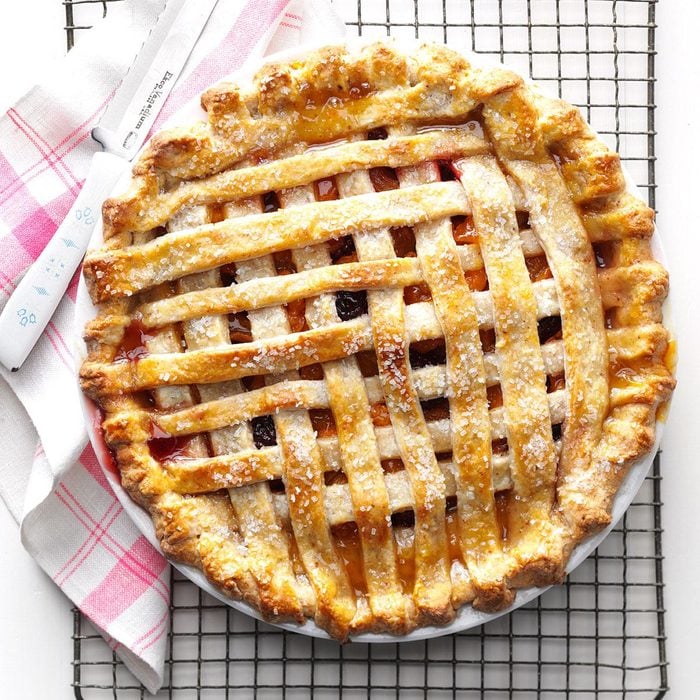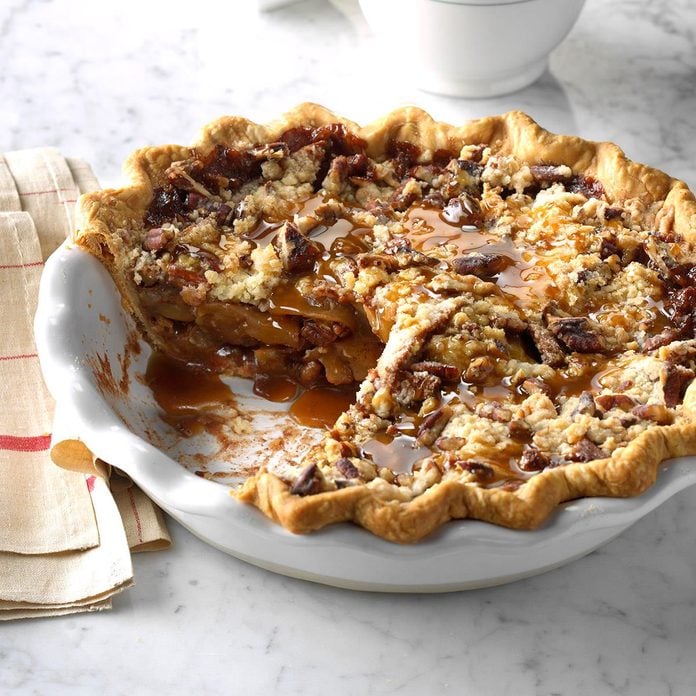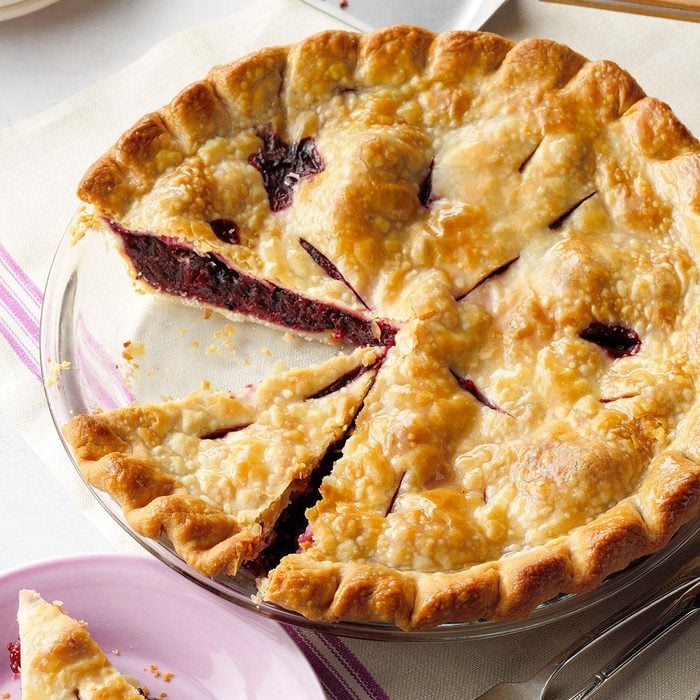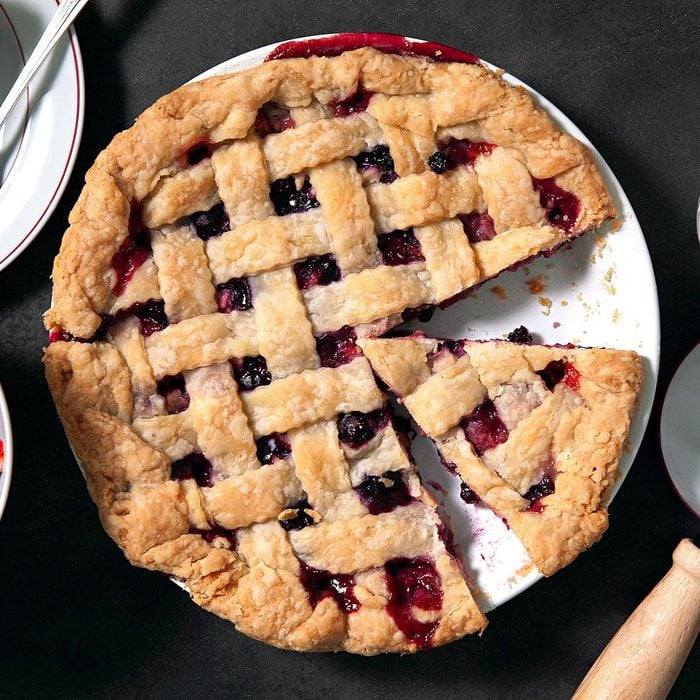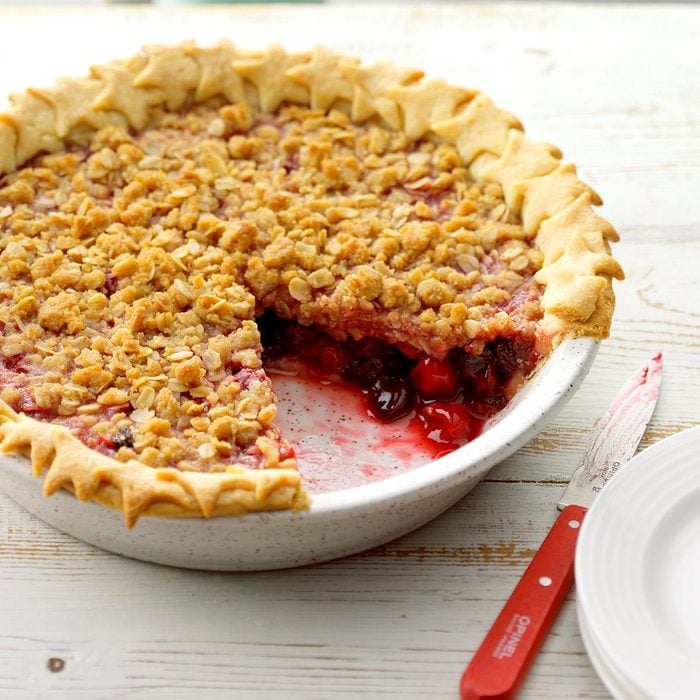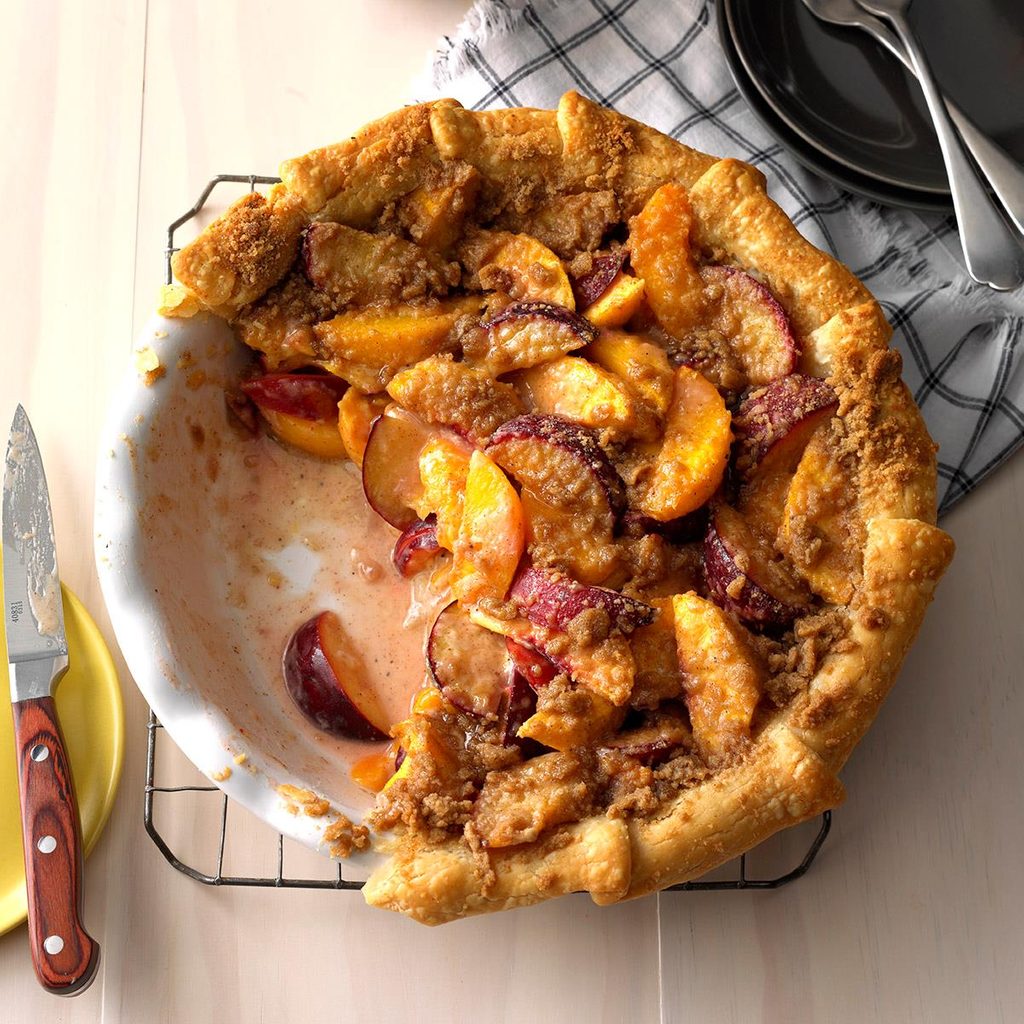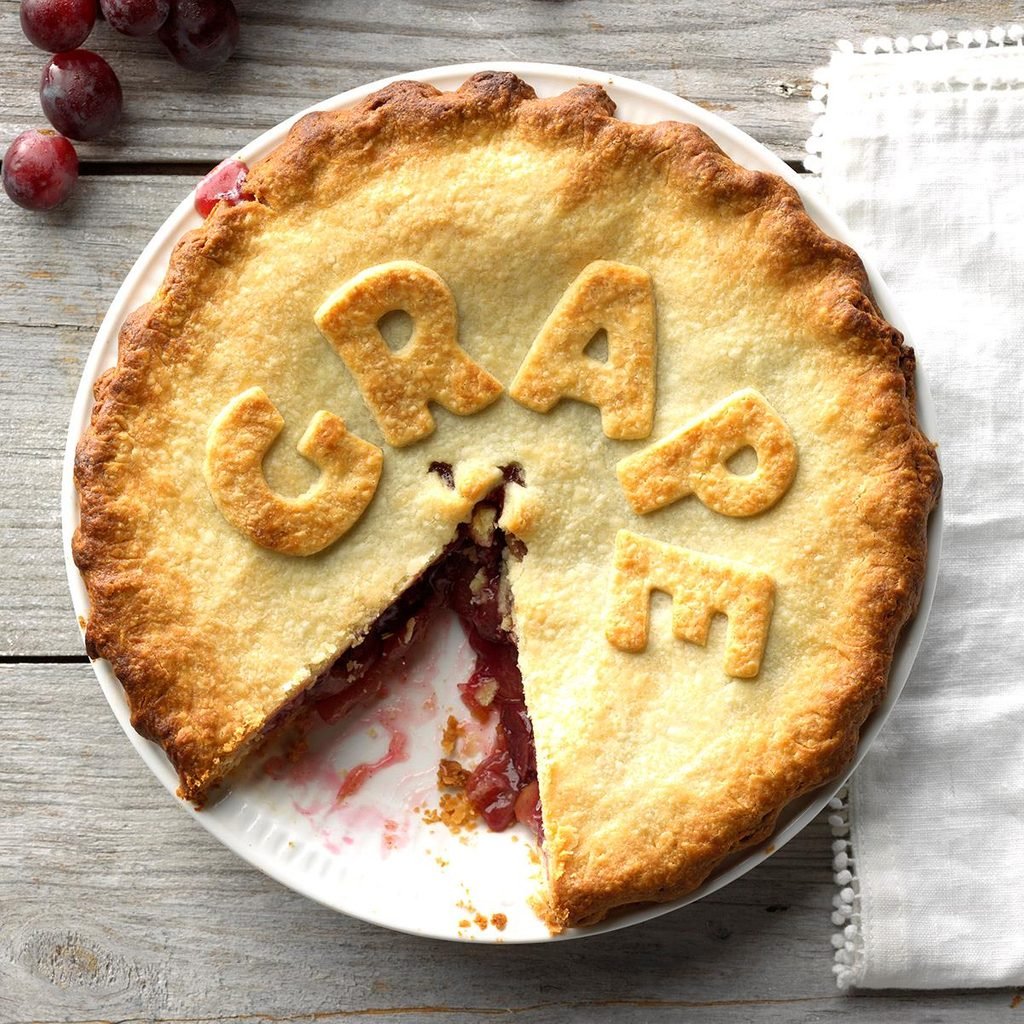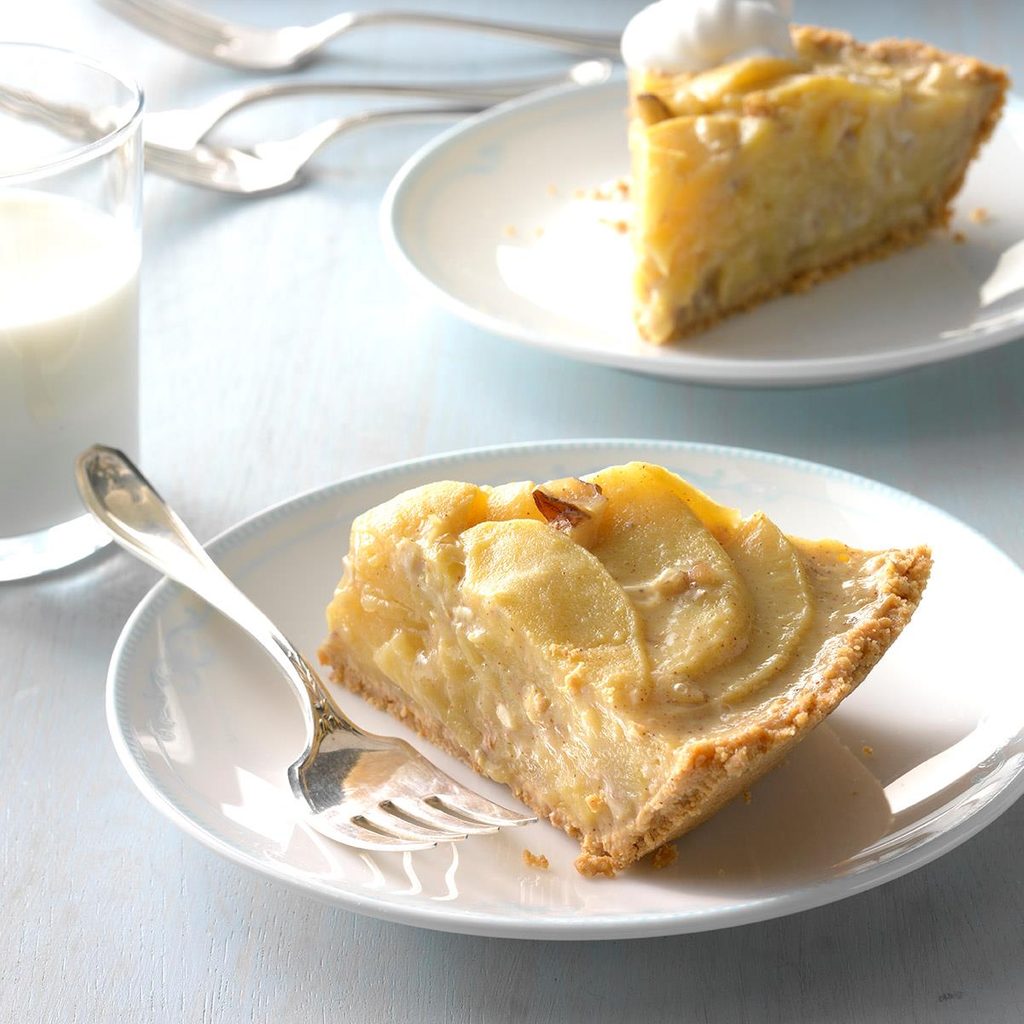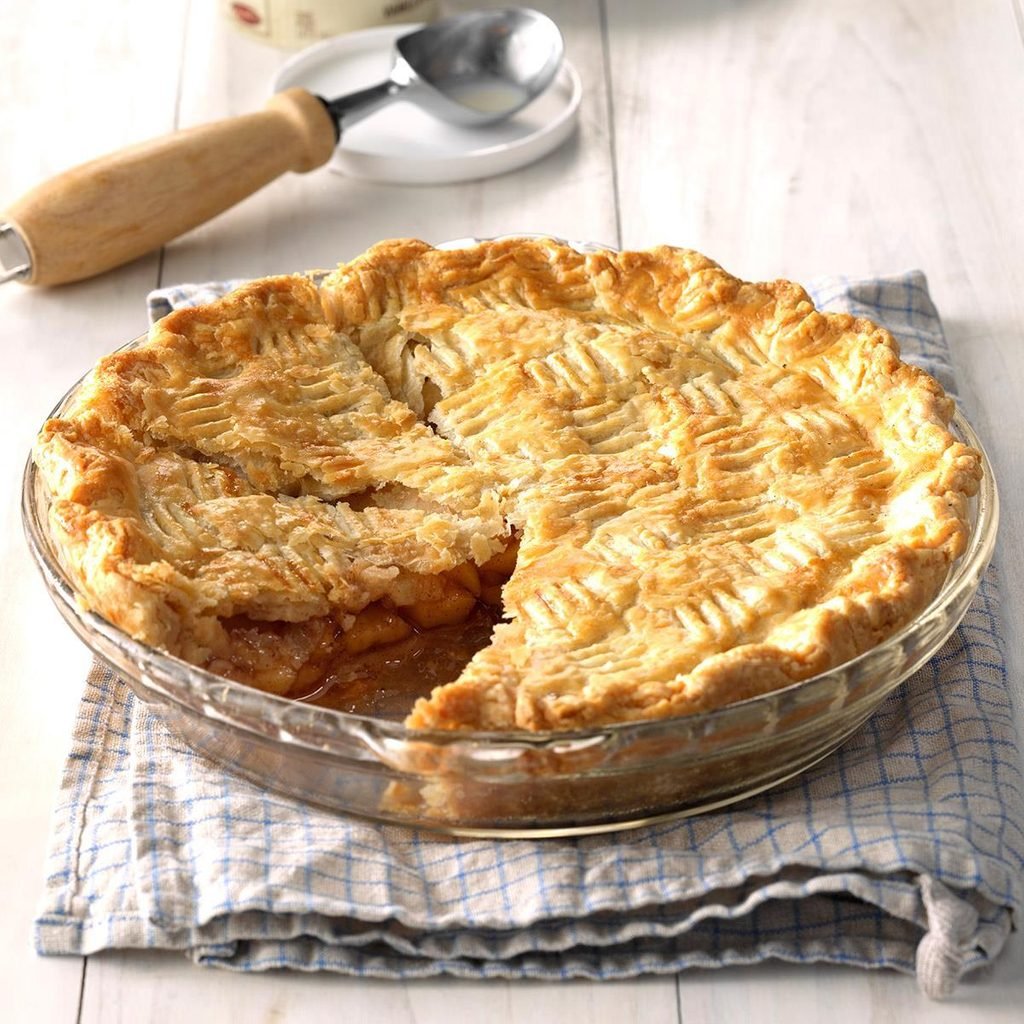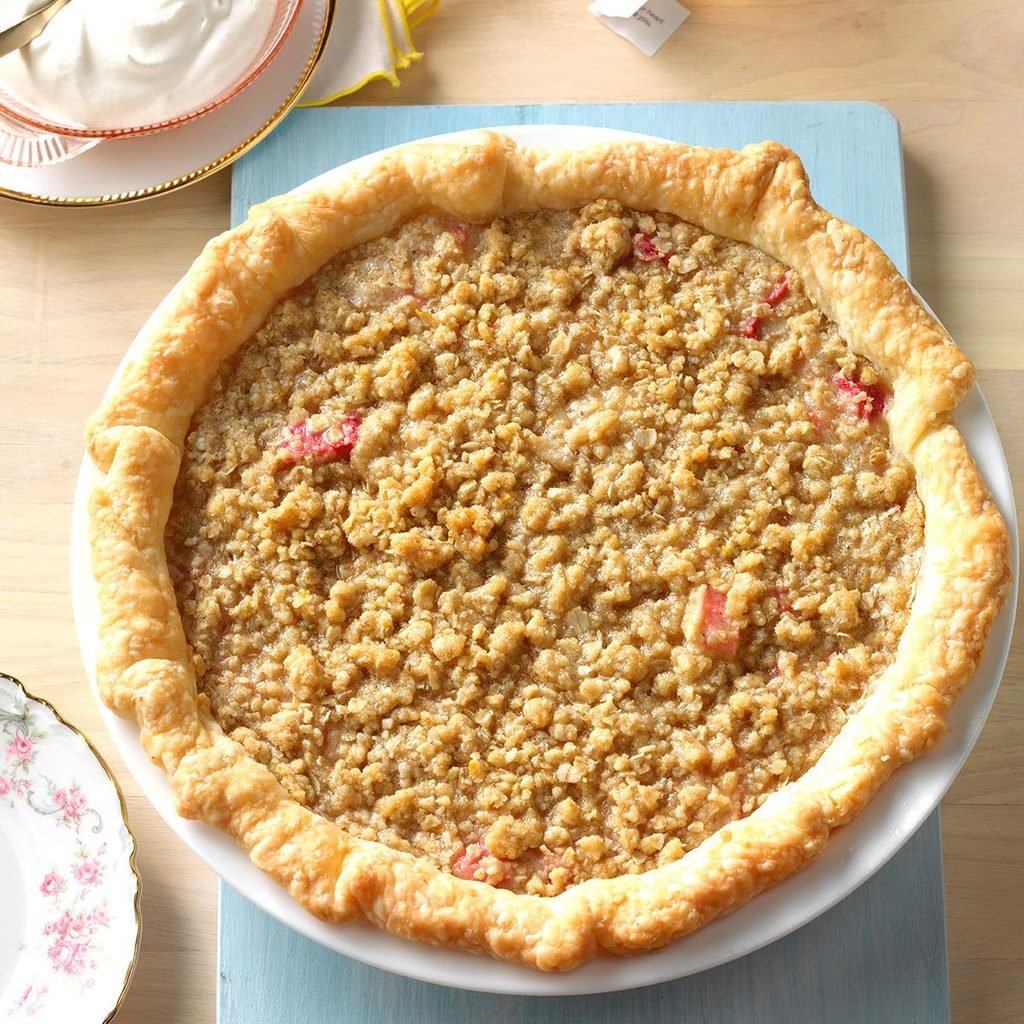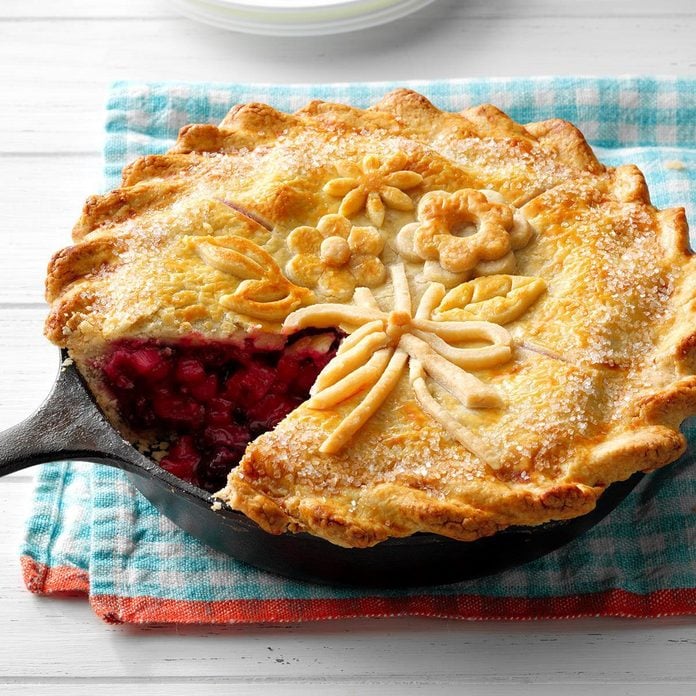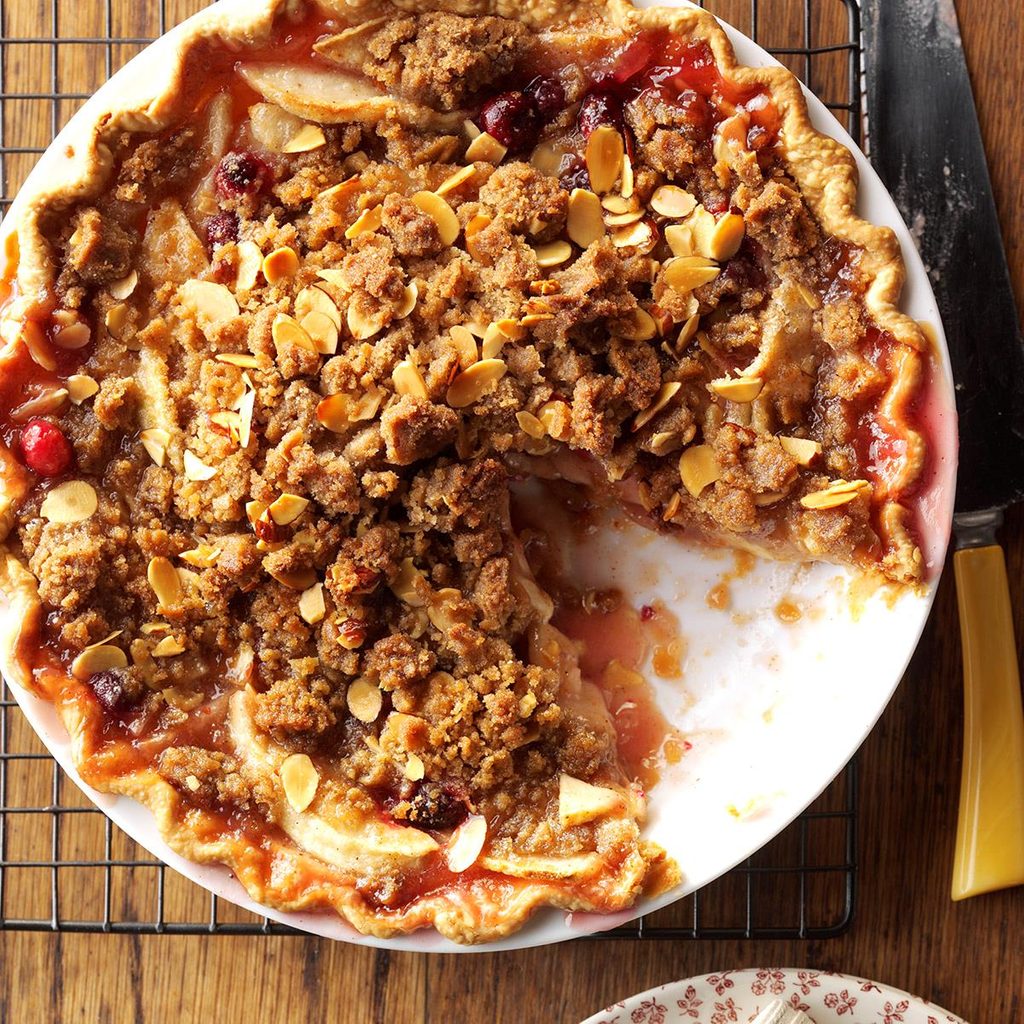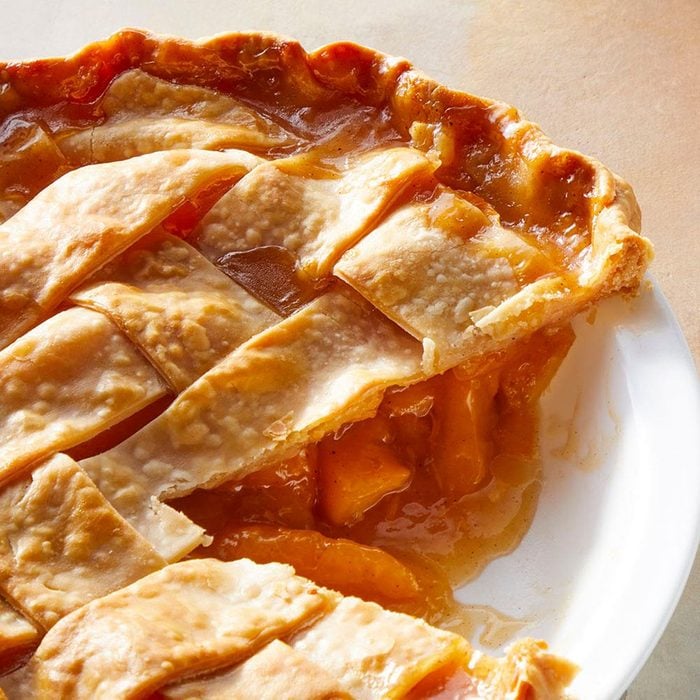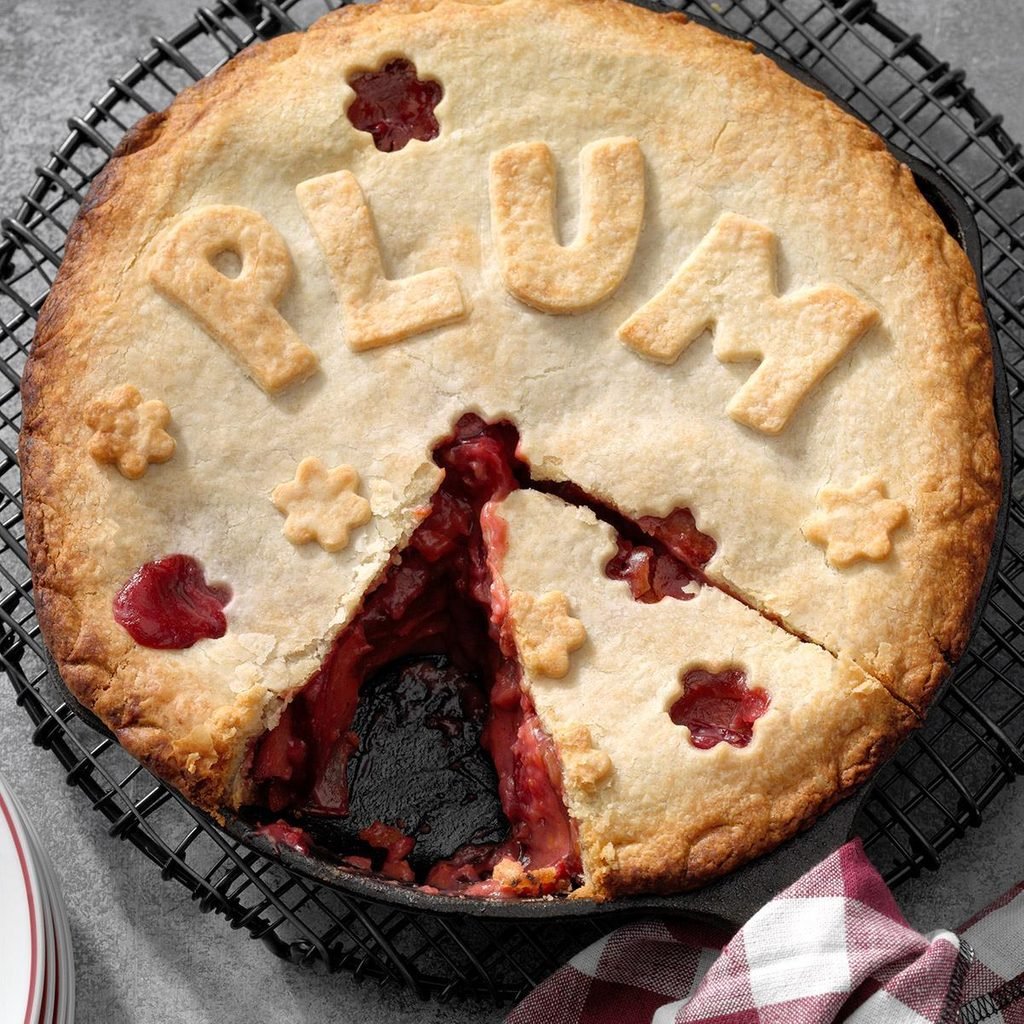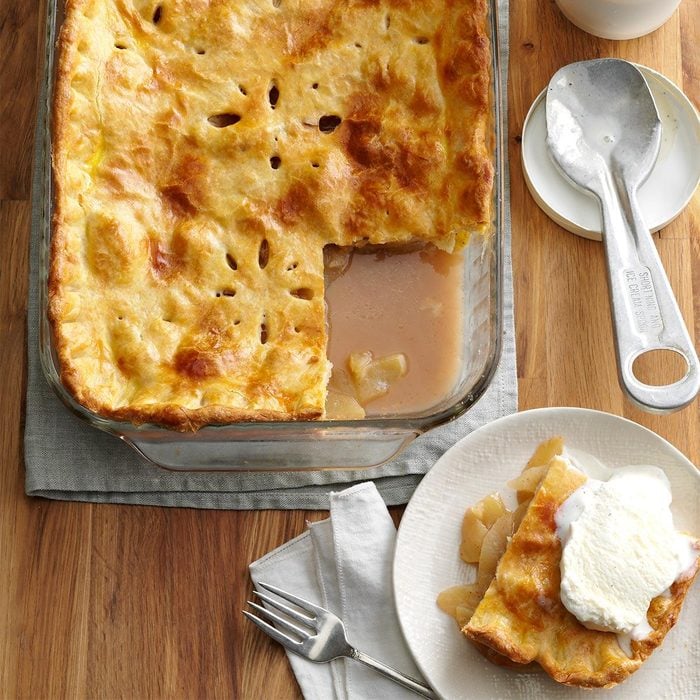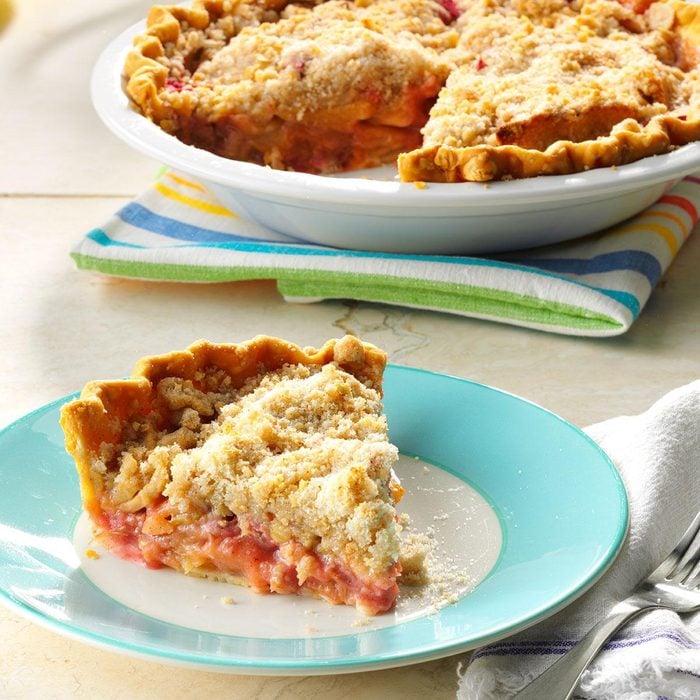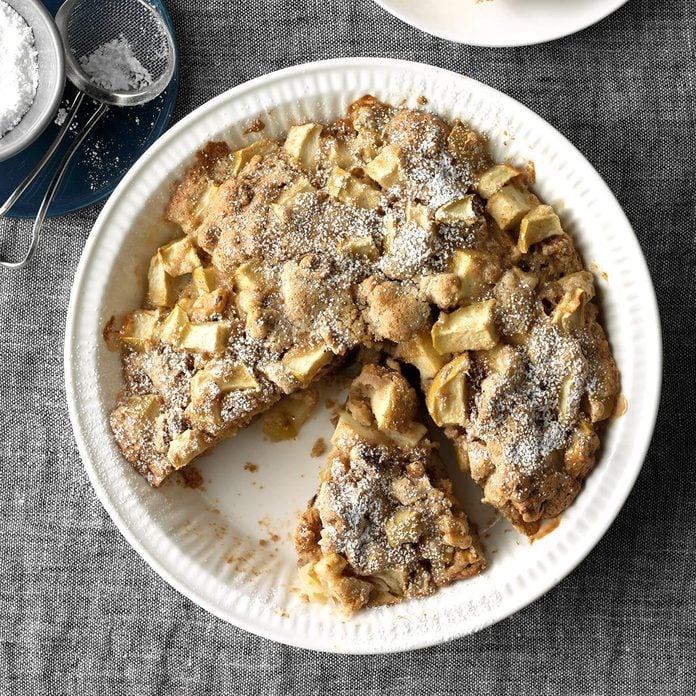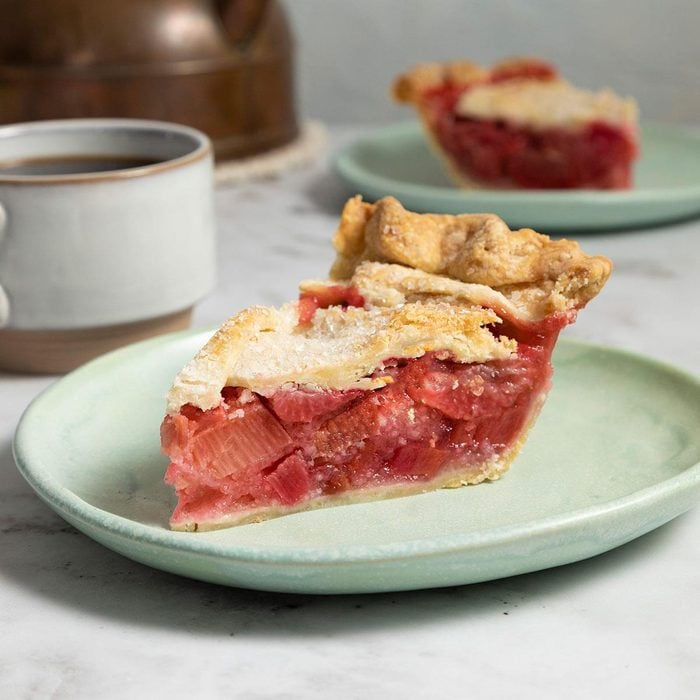 Taste of Home
Taste of Home
For my mother's birthday, I made this strawberry pie recipe instead of a cake. Since it was mid-May in Oklahoma, the berries were absolutely perfect. It was a memorable occasion for the whole family. —Josh Carter, Birmingham, Alabama
Go to Recipe
Psst... Get tips on
how to make the perfect lattice crust.
Peach Crumble PieA delightful summertime pie, this dessert is overflowing with fresh peach flavor. Each sweet slice is packed with old-fashioned appeal. The streusel topping makes this peach crumble pie a little different than the ordinary and adds homemade flair. —Sally Holbrook, Pasadena, California
Maine Blueberry Pie with Crumb ToppingI make this delicious fruit pie with small Maine berries, but you can use any variety you like. The shortbread topping adds a sweet crunch. — Jessie Grearson, Falmouth, Maine
Contest-Winning Rhubarb Meringue PieMy husband’s grandmother was an excellent cook, but she didn’t always share her secrets. Luckily, we have her rhubarb pie recipe. I added one of my favorite crusts and a never-fail meringue. —Elaine Sampson, Colesburg, Iowa
Plum & Hazelnut PieMy mom taught me about Italian prune plums and pie. Sprinkling the crust with ground hazelnuts gives it a luscious flavor and also keeps it from getting soggy. —Trisha Kruse, Eagle, Idaho
Cherry Pear PieTwo of my family's favorite fruits appear in this splendid pie with a nutty streusel topping. I like to serve slices with cherry-vanilla frozen yogurt.—Trisha Kruse, Eagle, Idaho
Banana Fudge PieThis dessert, which is like a banana sundae, is both light and good. I make it often. —Myra Innes, Auburn, Kansas
Key Lime Cream PieI am very proud of this luscious no-bake beauty. It's so cool and refreshing—perfect for any summer potluck or get-together. Wherever I take this pie, it quickly disappears, and everyone asks for the recipe. —Shirley Rickis, Lady Lake, Florida
Strawberry Cream Cheese PieCheesecake lovers will savor every bite of this light and pretty pie, even if they don't have to watch their diets. Our whole family enjoys it. —Kim Van Rheenen, Mendota, Illinois
Pear Gruyere PieI love cheese and fruit, so this pie is a natural pairing for me. Sweet and spicy wine-poached pears and a flaky, buttery cheese crust make for a winning dessert you’ll want to make again and again. If you’re serving this for Thanksgiving, bake leaf-shaped pie pastry on top for a festive look. —Alexandra Penfold, Brooklyn, New York
Blackberry Apple PieMy mother made this pie so often, she could do it with her eyes closed! We picked the berries ourselves, and the apples came from the trees in our orchard. I can still taste the delicious combination of fruits encased in Mother's flaky pie crust. —Fran Stanfield, Wilmington , Ohio
Cherry Hand PiesThere's nothing better than a sweet, from-scratch delight like traditional cherry pie. These precious little hand pies always go fast when I sell them at my pie bakery! —Allison Cebulla, Milwaukee, Wisconsin
Sour Cream Apple PieA cool, creamy version of the original, this delicious dessert is the perfect finish to a satisfying summer meal. Its crumbly topping and smooth apple filling are crowd-pleasers! Be prepared to serve seconds. —Sharon Bickett, Chester, South Carolina
Homemade Pear PieI entered this pie in a local baking contest and ended up winning! Bartlett pears hold up well when baked, adding a nice layer of texture. —Darlene Jacobson, Waterford, Wisconsin
Cast-Iron Cherry-Berry Peach PieI had an overabundant supply of cherries one year, so I adapted several recipes to use them up. I knew this one was a keeper when I received phone calls from my mother and grandmother complimenting me on this pie. —Amy Hartke, Elgin, Illinois
Apple PieI remember coming home sullen one day because we'd lost a softball game. Grandma, in her wisdom, suggested that maybe a slice of hot apple pie would make me feel better. She was right. —Maggie Greene, Granite Falls, Washington
Pineapple Pie with Coconut CreamYou’ll find pineapples and coconuts everywhere in the South Pacific, so we play them up in this creamy cool pineapple pie, dolloped with coconut cream. Divine! —Karen Naihe, Kamuela, Hawaii
Creamy Lime Pie with Fresh BerriesI combined the tangy tastes of lime and cilantro with cream cheese for this unusual berry pie that showcases seasonal fruit. The ginger cookies add zip to the crust. —Anneliese Barz, Fort Mill, South Carolina
Banana-Pineapple Cream PiesMy mother gave me this simple and delicious recipe years ago. The recipe makes two pies, so it's perfect for a potluck. I've never met anyone who didn't like it! —Robyn Appenzeller, Portsmouth, Virginia
Gingersnap Crumb Pear PieThis basic recipe was one my grandmother used for making crumble pies from fresh fruit. She simply substituted oats, gingersnaps or vanilla wafers depending on the fruit. Pear was always my favorite, and I added the ginger and caramel to give it a new twist. —Fay Moreland, Wichita Falls, Texas
Raspberry-Rhubarb Slab PieSlab pie is a pastry baked in a jelly-roll pan and cut into slabs like a bar cookie—or a pie bar, if you will. My grandfather was a professional baker and served pieces of slab pie to his customers back in the day. Here is my spin, featuring rhubarb and gorgeous red raspberries. —Jeanne Ambrose, Milwaukee, Wisconsin
Lemon Supreme PieA friend and I often visit a local restaurant for pie and coffee. When they stopped carrying our favorite lemon supreme pie, I got busy in the kitchen and created this version, which we think tastes even better! The combination of the cream cheese and tart lemon is wonderful. —Jana Beckman, Wamego, Kansas
Creamy Chocolate-Banana PieYou can make almost any dessert more awesome with chocolate. In this cream pie, fresh banana and chocolate make a truly irresistible combo.
—Diane Nemitz, Ludington, Michigan
Marshmallow-Almond Key Lime PieSummer is peak season for Key limes—a must for this pie’s distinctive sweet-tart flavor. Unlike other Key lime pies, mine has a smooth marshmallow layer on top. This makes it stand out as a crowd favorite. —Judy Castranova, New Bern, North Carolina
Apricot-Blackberry PieBlackberries became my favorite fruit after I harvested them from my grandfather’s yard in Greece. I mix them with apricots to make the pie of my dreams. —Simone Bazos, Baltimore, Maryland
Caramel-Pecan Apple PieYou'll love the smell in your kitchen—and the smiles on everybody's faces—when you make this scrumptious caramel apple pie recipe. It takes me back home to Virginia, to my granny's table. —Jean Castro, Phoenix, Arizona
Fresh Blackberry PieI grew up on a farm, and we always picked fruits in early summer and used them to make desserts. This blackberry pie recipe is a real stunner. —Gladys Gibbs, Brush Creek, Tennessee
Flaky Bumbleberry PieWhen you want to make an impression, make this pie! The recipe produces one of the flakiest crusts ever, and the combination of rhubarb and different berries in the filling is delicious. —Suzanne Alberts, Onalaska, Wisconsin
Michigan Cherry PieThis tart Michigan cherry pie is delicious with the streusel topping but even better crowned with a scoop of vanilla ice cream. —Diane Selich, Vassar, Michigan
Perfect Plum & Peach PieI created this recipe for in-season summer fruit. The plums give the pie a splash of color as well as flavor, and the crumb topping is both easy and excellent! —Rachel Johnson, Shippensburg, Pennsylvania
Ruby Grape PieMy wife, Paula, and I produce red and green seedless table grapes on our 75-acre vineyard. Our crop is wonderful eaten out-of-hand or in salads. Paula also uses them in this unusual and tasty pie.—Salvage Island Farm, Fred Smeds, Reedley, California
Psst! Here's another
grape pie recipe you'll love.
No-Bake Apple PieWe always have an abundance of apples in the fall, so I like to make this easy pie. My husband has diabetes, and this recipe fits into his diet ... but everyone enjoys it. —Shirley Vredenburg, Ossineke, Michigan
Golden Apple PiePies are the dessert I like best to prepare. This one's the favorite for family get-togethers, and it has been awarded blue ribbons at a couple of local fairs. —Theresa Brazil, Petaluma, California
Sour Cream Rhubarb PieA hint of orange flavor and a nice blend of spices complement the tangy rhubarb. I like to serve the pie while it's still warm. —Doreen Martin, Kitimat, British Columbia
Bluebarb PieIf you're a fan of strawberry-rhubarb pie, you'll want to try this twist on the classic. Here, blueberries provide the sweet counterpoint to the tart rhubarb, with mouthwatering results. —Steve Gyuro, Franklin, Wisconsin
Cranberry-Almond Apple PieMy grandmother made this treat every year for Christmas. It’s much better than everyday apple pie. The recipe is a family treasure. —Maxine Theriauit, Nashua, New Hampshire
Peach PieI acquired this delicious peach pie filling recipe some 40 years ago, when my husband and I first moved to southern Iowa and had peach trees growing in our backyard. It's been a family favorite since then and always brings back memories of both summer and those happy early years. — June Mueller, Sioux City, Iowa
Upside-Down Apple PieThis pie has won eight ribbons at area fairs. People say it looks and tastes like a giant apple-cinnamon bun. I take time off from work around the holidays to fill pie requests from family and friends. The recipe has become everyone's favorite. —Susan Frisch, Germansville, Pennsylvania
Spiced Plum PieThe subtle tastes of orange and nutmeg bring out the fresh flavor of plums in this comforting pie. Be sure to have a slice while it's still warm, with a scoop of vanilla ice cream. —Lucille Mead, Ilion, New York
Deep-Dish Apple PieThis deep-dish apple pie is a winner! The crust is so flaky and the filling is sure to please everyone. —Salem Cross Inn, West Brookfield, Massachusetts
Apple Rhubarb Crumb PieMy family and friends always ask for my apple rhubarb pie for birthdays and get-togethers. Everyone loves the unique flavor that the rhubarb adds to this pie. —Sherri Moon, Decatur, Indiana.
Red, White and Blueberry PieThis creamy pie gets dressed up with berries to make a showstopping display at any Fourth of July party or summer get-together. It's as pretty as it is tasty! —Kimberly McFarland, Broken Arrow, Oklahoma
Swedish Apple PieThis decadent Swedish apple pie serves up homemade flavor in every bite. This is a perfect snack with coffee or as an after-dinner treat. —Sarah Klier, Grand Rapids, Michigan
Strawberry Rhubarb PieWhile growing up on a farm, I often ate rhubarb, so it's natural for me to use it in a pie. I prefer to use lard for the flaky pie crust and thin red rhubarb stalks for the filling. These two little secrets helped this strawberry rhubarb pie recipe win top honors at the 2013 Iowa State Fair. —Marianne Carlson, Jefferson, Iowa
